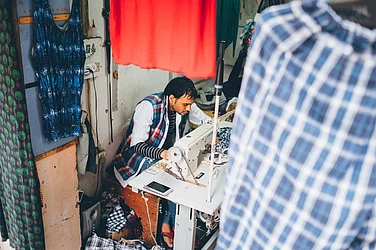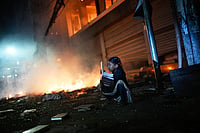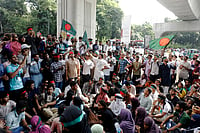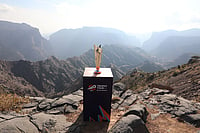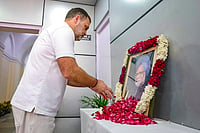VISITORS to enter at their own risk." The Dantean caveat stares you in the face as you near the guarded iron gates. But you have to go behind the iron curtain to discover the untold tales of desperation and disease, death and destruction, bravado and fatalism, fear and oppression,
greed and exploitation. Yet, from atop a promontory on the western edge of the Bhavnagar coast in Gujarat, the sight is breathtaking. Over 200 discarded ships of various shapes and sizes parked in 183 plots along a 10 km-stretch make up Alang, the world's biggest shipbreaking yard with an annual turnover of Rs 2,000 crore and a labour force of 40,000.
Enter the surreal world of Alang, a latter-day labour camp with echoes of the infamous Russian variety. Except for the fact that the State here is a willing accomplice and not the chief inquisitor, the four horsemen—fear, disease, boredom, and death—are very much there. This Dantean hell remained obscure till April 22 last year, when 50 workers were reported to have perished in an explosion on an oil tanker in plot 48. Officials of Gujarat Maritime Board (GMB), the custodian of the yard, put the figure at 16. And on January 21 this year, workers allege, a cylinder-burst in plot 10 claimed another five lives. Like many more before, however, this 'small' accident went unreported.
The April 22 disaster exposed to the outside world a little of the hell that is Alang. How many perish in a year, or even how many died since the yard came into being in 1982, is anybody's guess. Reports vary from one death a day to a couple in two months. The truth probably lies midway—two or three every month. Given the perils the workers are exposed to, as well as the lack of safety measures and their lax enforcement, the figure may not be too wide off the mark. Dr D.B. Parekh, who often treats Alang patients in his Bhavnagar hospital, puts the annual death figure at 20. Says Mite Ram, a worker who was crippled for life when a steel pipe fell on him: "In a month, 10-15 major accidents occur in the yard." According to the International Labour Organisation, India has the third highest number of fatal accidents in the manufacturing sector—about 25 for every lakh workers. Which makes the Alang death rate thrice as high as the national rate. It isn't just the stench of death that has hit public nostrils. Several seedy truths about the workers' plight have come to light in the last year. For instance, even though this industry falls under the Factories Act, Qamaruddin, 40, started work here in 1987 on a daily wage of Rs 20 for eight hours. After 10 years of gruelling and dangerous work he gets a measly Rs 60 per day—according to the Minimum Wages Act it should be Rs 70. Even now, when the yard is open to media glare, novices are paid as low as Rs 40 a day.
The more dangerous the work, the higher the wages. Among the workers, gas cutters earn the most, ranging from Rs 70 to a grand high of Rs 130 for an exhausting eight-hour day. Theirs is the most dangerous work: dismantling the engine room which houses the fuel tank or cutting the topmost portion of the ship. Not surprisingly, most deaths occur due to gas explosions in the ship or cylinder bursts on ground.
Shockingly enough, till June last year, the GMB had no worker safety guidelines whatsoever. Though shipbreaking is covered under various statutes—the Explosives Act 1984, Explosive Substances Act 1908, Petroleum Storage Act 1976, Factory Act 1948, among others—the industry had been operating without any guidelines for over 15 years! And, without safety guidelines, risks rapidly translate into death. Helmets, gloves, gumboots—mandatory in any hazardous industry—were unheard of in Alang till last June when the Gujarat and Sosiya shipbreakers associations signed an MOU with GMB to provide, and enforce, safety measures. The MOU expired in August last year and the expert committee constituted to draw up a detailed list of safety rules and regulations is yet to deliver its report.
In the meantime, many workers can still be seen working without helmets or glasses. Shipbreakers argue that the workers aren't used to helmets—not surprising, as the workers say helmets haven't as yet been provided to them.
The apathy on the part of the shipbreakers often proves fatal. For instance, all ships must be certified as gas-free before they can be beached. But often it is not possible to make the ships completely gas-free, and deadly fires often result. Likewise, after the ship is beached the shipbreaker is supposed to pump out the fuel oil and remove the sludge—which is unfortunately often dumped into the sea—before they can be dismantled. However, the lack of knowledge, negligence, and sheer callousness on the part of the shipbreakers often lead to explosions.
Of late, environmental groups like Greenpeace and Delhi-based Toxics-Link have taken up the issue of breaking ships that have toxics like PCBs, asbestos and lead. An issue that is likely to become worse in the near future. A recent report in the US daily Baltimore Sun stated: "With its American scrapping programme entangled in worker-safety problems, criminal charges, bankruptcies and suits, the US navy may drop its old policy and simply export its obsolete ships laden with toxics to India, Bangladesh or Pakistan."
While death lurks too close for comfort, life is made tougher for the workers by the presence of slave-drivers called muqadams. The muqadam, the shipbreakers' loyal right-hand man, runs the entire show at the plot. To meet deadlines for breaking the ship, workers say the muqadams often make them work harsh hours. According to Ramesh Sankhli, 24, he was forced to work for six months for a paltry Rs 40 for 12 back-breaking hours. "As a result, we often end up working at night, risking our lives. The explosion on March 31 last year which killed seven workers occurred because a drunk muqadam forced a worker to cut a pipe suspected to be full of gas," says a worker who was burnt in the accident. Little wonder then that accidents are commonplace. According to one estimate, an average of 2,000 workers are treated for injuries every month at the Red Cross hospital at Alang.
Injuries besides, the general state of health of the workers is very poor. According to the Red Cross, 350 leprosy cases were detected last year, besides stray cases of HIV and TB. The high rate of illness can be gauged from the fact that there are more than 200 ayurvedic physicians in Alang, but most dispense allopathic medicines.
Dr Asmat Siddique says he treats about 15 to 20 patients every day. And routinely prescribes antibiotics for malaria and pneumonia which, he says, are quite common. As are respiratory problems caused by open burning of huge amounts of solid waste such as broken steel pipes, asbestos, glass wool, foam material, rubber pipes at the plot.
Alongside the industrial hazards, Alang has all the ills common to groups of workers living in makeshift chawls—including inadequate supply of power and water. "At times we have to go without a bath for days together," says Sitaram. And when the tanker water runs out, workers are forced to drink water from nearby wells, which are often saline. Human waste is another health hazard. There are no proper latrines and the sewage is generally dumped directly into the sea—the GMB and the shipbreakers are currently in court over who should install a treatment plant for human waste.
Justifies Ajay Mehta, honorary secretary of the Sosiya Shipbreakers Association: "Compared to their lives back home, this is heaven. They are the highest-paid unskilled workers in India and should have no cause for complaint."
Yet, if Alang is one long unending nightmare, why do hordes of workers from Orissa, Bihar and UP flock to it? Poverty drives them to desperation, they say. Gas cutter Lahri Singh, 30, explains that he is not happy here, but is helpless. "I know my life is always in danger, but this is the only way I can support my family back home."
GMB has drawn up a master plan for the development of Alang which includes quarters for workers, a check-dam to create a reservoir for drinking water, a trauma hospital, and power supply. But Mehta is cynical: "Four years ago, they charged the shipbreakers Rs 2,700 per square metre for a period of 10 years with the promise that they would build roads and other infrastructure. But, barring the bridge connecting Sosiya and Alang, they have done precious little."
Mehta alleges that GMB has fostered an atmosphere of corruption in this industry. Till 1994, anybody in principle could lease a plot from GMB for Rs 200. "But only those who could grease the palms of GMB officials got the plot," says Mehta.
Between the politics of GMB and shipbreakers, the ordinary worker is completely forgotten, even as Alang has risen to a pre-eminent position in the industry. Today, directly or indirectly, Alang supports 5 lakh families through ancillary industry. And for the state and Central government, it's a golden goose that earns handsome revenues through sales tax, customs duty and Central excise, besides providing much-needed steel (2.6 million tonnes between 1996-97). And, possibly the biggest visible sign of its being a milch cow, the industry, according to Mehta, spends about Rs 5 crore each year as bribes for politicians. A sum that could surely go a long way towards alleviating the hellish existence of the workers behind the mega-industry.












